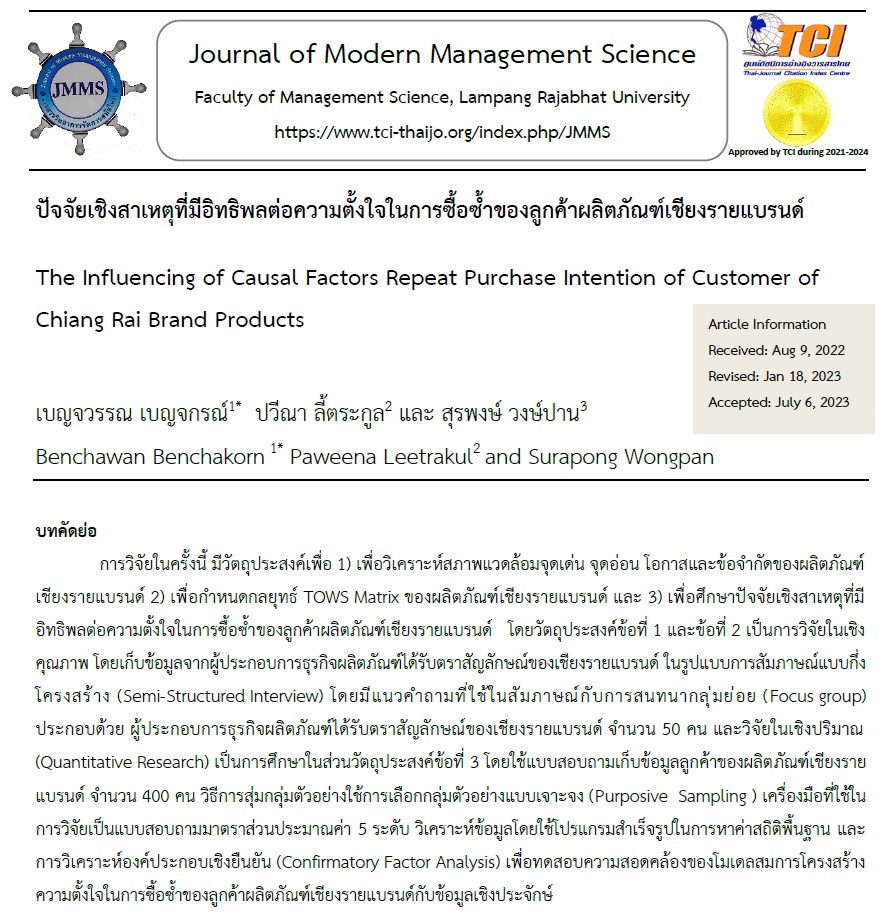The Influencing of Causal Factors Repeat Purchase Intention of Customer of Chiang Rai Brand Products
Main Article Content
Abstract
This article aimed to 1) to analyze the environment, strengths, weaknesses, opportunities, and limitations of Chiang Rai brand products; 2) to formulate TOWS Matrix strategies for Chiang Rai brand products; and 3) to study the influence of brand awareness, products, and satisfaction with the purchase intention of customers regarding Chiang Rai brand products. Objectives 1 and 2 are qualitative research, studying concepts from business entrepreneurs, and products that have been branded with the Chiang Rai brand via a semi-structured interview format (Semi-Structured Interview). Questions were asked in interviews with a focus group consisting of 50 product business entrepreneurs who received the Chiang Rai brand logo. Furthermore, quantitative research was conducted pertaining to the fourth objective by using a questionnaire to collect data on customers of Chiang Rai brand products, consisting of 400people. The 5-level estimation scale questionnaire analyzed the data by using a packaged program for Data were analyzed by using software program for basic statistics and confirmatory factor analysis to test the model consistency, the structural equation of brand awareness and satisfaction with repeat purchase intention of customers of Chiang Rai brand products, which focused on empirical data.
The results evaluated 5 factors affecting repeat purchase intention of customers of Chiang Rai brand products, sorted in descending order of composition weight, including 1) Brand awareness (.995), 2) Satisfaction (.150), 3) Customer expected expectations (.065), 4) Value of products and services (.013), and 5) Quality of products and services (.009), in order to prioritize each component consistent with the empirical data evidence.
Article Details

This work is licensed under a Creative Commons Attribution-NonCommercial-NoDerivatives 4.0 International License.
The article must be considered and accepted for publication by the editorial board of the Faculty of Management Science, Lampang Rajabhat University. The articles have been reviewed by a peer (peer review) and the author must update according to the suggestion if available before publication. Articles that are not considered the editorial team will inform the results of the consideration but will not send the original to the author.
JMMS is the Faculty of Management Science journal, Lampang Rajabhat University. Jmms published both print and online editions. We allow the use of articles for academic use under the scope of copyright law.
References
กัลยา วานิชย์บัญชา. (2549). สถิติสำหรับงานวิจัย. กรุงเทพฯ : จุฬาลงกรณ์มหาวิทยาลัย
บดินทร์ภัทร์ สิงห์โต. (2560). พฤติกรรมการเลือกซื้อและปัจจัยที่มีผลต่อความตั้งใจกลับมาซื้อซ้ำของลูกค้าตลาดนัดสวนจตุจักร. (สารนิพนธ์ ปริญญาบริหารธุรกิจมหาบัณฑิต). กรุงเทพฯ: มหาวิทยาลัยกรุงเทพ.
พินิจ แก้วจิตคงทอง. (2565). เชียงรายผลักดัน “Chiang Rai Brand” มุ่งสู่การค้าการลงทุน พัฒนาเศรษฐกิจพิเศษชายแดน. สืบค้นเมื่อ 10 กรกฎาคม 2565. จาก https://www.chiangmainews.co.th/news/1967336/.
พีรวิชญ์ ธีระกาญจน์ และ สุรสิทธิ์ อุดมธนวงศ์. (2562). อิทธิพลของการรับรู้คุณค่าและการตระหนักรู้ตราสินค้าที่ส่งผลต่อการซื้อซ้ำของผลิตภัณฑ์ซีเรียลผ่านช่องทางออนไลน์ของผู้บริโภคในเขตกรุงเทพมหานคร. วารสารบริหารธุรกิจ มหาวิทยาลัยแม่โจ้. 1(2), 60-71.
เมขลา สังตระกูล. (2558). อิทธิพลของคุณค่าที่รับรู้ต่อความไว้เนื้อเชื่อใจ ความพึงพอใจ การบอกต่อ และการกลับมาซื้อซ้ำของผู้บริโภคอาหารเพื่อสุขภาพในเขตกรุงเทพมหานคร. (วิทยานิพนธ์ ปริญญาบริหารธุรกิจมหาบัณฑิต). กรุงเทพฯ: มหาวิทยาลัยกรุงเทพ.
วรันพร นางาม. (2562). อิทธิพลของปัจจัยเชิงสาเหตุที่ส่งผลต่อความตั้งใจซื้อซ้ำอาหารคลีน ของผู้บริโภคในเขตกรุงเทพมหานคร. (วิทยานิพนธ์ ปริญญามหาบัณฑิต). กรุงเทพฯ: มหาวิทยาลัยเทคโนโลยีราชมงคล.
วินิจ แซ่เตียว และสุรสิทธิ์ อุดมธนวงศ์. (2563). ปัจจัยเชิงสาเหตุที่ส่งผลต่อความตั้งใจในการซื้อซ้ำของผู้บริโภคที่ใช้ผลิตภัณฑ์ลดอาการเมาค้างในเขตกรุงเทพมหานคร. วารสารสถาบันเทคโนโลยีไทย-ญี่ปุ่น : บริหารธุรกิจและภาษา. 8(1), 53-63.
วิษณุ เทศขยัน. (2564). All About Branding: แบรนด์และการสร้างแบรนด์คืออะไร ตอบทุกข้อสงสัยใน 15 นาที. สืบค้นเมื่อ 10 กรกฎาคม 2565. จาก https://positioningmag.com/1315999.
ศุภรา เจริญภูมิ. (2560). ปัจจัยที่ส่งผลต่อความตั้งใจซื้อซำของผู้บริโภคต่อธุรกิจร้านค้าปลีกดั้งเดิมในกลุ่มจังหวัดภาคใต้ฝั่งอันดามัน. วารสารบริหารธุรกิจเทคโนโลยีมหานคร. 14(2), 41-58.
สำนักงานพาณิชย์จังหวัดเชียงราย. (2565). การประชุมคณะกรรมการบริหารตราสัญลักษณ์ฯ ประชุมพิจารณาอนุญาตให้ผู้ประกอบการใช้ตราสัญลักษณ์ผลิตภัณฑ์ จังหวัดเชียงราย. การพิจารณาผู้ประกอบการที่ขออนุญาตใช้ตราสัญลักษณ์ผลิตภัณฑ์จังหวัดเชียงราย. ห้องประชุมพญาพิภักดิ์ ชั้น 2 ศาลากลางจังหวัดเชียงราย.
อัษฎาพร วงษ์พิพัฒน์พันธ์. (2563). ความตระหนักรู้ในตราสินค้า ความสอดคล้องกับตนเอง ความเป็นเอกลักษณ์เฉพาะ สื่อสังคมออนไลน์และความพึงพอใจที่ส่งผลต่อการตัดสินใจซื้อน้ำหอมแบรนด์เนมของผู้บริโภคในกรุงเทพมหานคร. (สารนิพนธ์ ปริญญาบริหารธุรกิจมหาบัณฑิต). กรุงเทพฯ: มหาวิทยาลัยกรุงเทพ.
อาภาชินี มารอด . (2557). อิทธิพลของคุณค่าที่รับรู้ และภาพลักษณ์ตราสินค้า ต่อความไว้เนื้อเชื่อใจ ความพึงพอใจ การบอกต่อและการกลับมาใช้บริการซ้ำของผู้เรียนสถาบัน Studio Academy. (สารนิพนธ์ ปริญญาบริหารธุรกิจมหาบัณฑิต). กรุงเทพฯ: มหาวิทยาลัยกรุงเทพ.
Aaker, D. (1991). Managing brand equity: Capitalization the value of a brand name. New York: Free.
Anderson, J. C., & Gerbing, D. W. (1988). Structural equation modeling in practice: A review and recommended two-step approach. Psychological Bulletin. 103(3), 411-423.
Keller, K. L. (1993). Strategic Brand Management: Building, Measuring, and Managing Brand Equity. (2nd ed). Englewood Cliffs, NJ.: Prentice Hall.
Kim, Galliers, Shin, Han & Kim. (2012). Factors influencing internet shopping value and customer repurchase intention. Electronic Commerce Research and applications. 11(4), 374 - 387.
Kotler, P., & Keller, K. L. (2009). Marketing management. (13th ed.). Upper Saddle River, NJ: Pearson Prentice-Hall.
Lin, A. Y.-S., Huang, Y.-T., & Lin, M.-K. (2015). Customer-Based Brand Equity: The Evidence from China. Contemporary Management Research. 11, 75-94.
Randall, G. (2000). Branding: A practical guide to planning your strategy. (2nd ed.). London: Kogan.
Sasmita, J., & Suki, N. M. (2015). Young consumers’ insights on brand equity: Effects of brand association. brand loyalty. brand awareness. and brand image. International Journal of Retail & Distribution Management. 43(3), 276-292.
Webster, F.E., & Keller, K.L. (2004). A roadmap for branding in industrial markets. Journal of Brand Management. 11(5), 388-402.
Wisner, J. D., & Stanley, L. L. (2007). Process management: Creating value along the supply chain. USA: Thomson South-Western.


